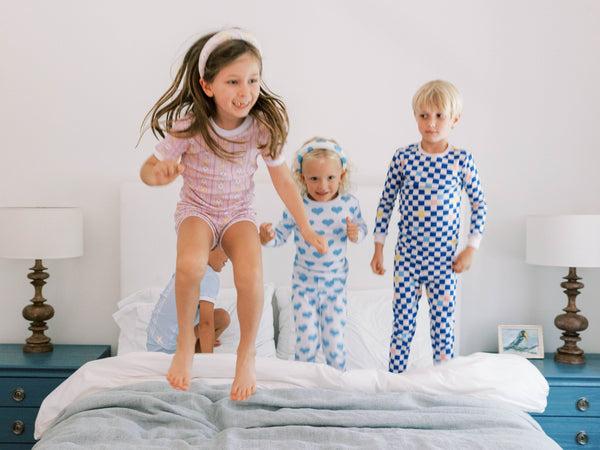
Summer bedtime routines for kids
During the last weeks of school, I would roll over in bed in the evenings to set my 5:30am alarm for the next day and find myself dreaming of summer mornings. Summer mornings and the inevitable extra hour of sleep, less rigorous routine and the type of freedom in our schedule that was sometimes hard to come by during the school year.

As I began plotting pool days and story times, park dates and museum visits I started to wonder about our bedtime routine. A friend sent me an invite to a kid-themed movie in the park that started at 8p, 30 minutes after my kids are typically asleep. Did the summer warrant longer days for the kids, too. Would they sleep in if we gave them the freedom to stay up later, chasing lightning bugs and indulging in movies in the park? I have one very flexible child who would likely just go put herself down for a nap if she needed more sleep the next day and another whose emotions run wild when she’s under slept. Would she adjust? I decided it was time to consult the experts!
Later bedtimes don’t equal later wake-ups
In the dream world of my mind, I like to think that a child who stays up an hour later will also wake up an hour later, but research shows that doesn’t seem to be true. “Night sleep, especially those first four to six hours, is the most restorative sleep your little one gets,” says Maggie Moore, founder of Get Moore Sleep. “Having a later bedtime can cause earlier wake-ups, where an earlier bedtime can aid in later wake-ups.”

Set the tone for a goodnight’s sleep
It can be confusing for kids climbing into bed as they stare out the window at broad daylight. So often in the summer the sun doesn’t set for more than an hour or two after a child’s bedtime.
“Since the production of melatonin – our sleepy hormone – is impacted by light, having a super dark bedroom will make it easier for your child to fall asleep and stay asleep even with the extra hours of sunlight. If you don’t already have blackout curtains, I’d highly recommend a minor room redecoration,” says Jamie of Oh Baby Consulting.
Kelly Murray of Kelly Murray Sleep reminds us that “The ideal temperature range for sleep is between 68 to 72 degrees. Most monitors these days display the room temperature. If yours doesn’t, then purchase a table top thermometer. Just because your thermostat is set to the perfect sleeping temperature it doesn’t necessarily mean that your child’s room is that same temp.”
“Once you ensure that their room is the appropriate temp, be sure to dress them appropriately, too. Reach for light-weight, breathable cotton pajamas, swaddles and sleep sacks. If their room is on the high end of the ideal temperature range, choose short sleeves. If it is on the low end, you will want to choose long sleeves and maybe even consider putting socks on their little tootsies.”

Give Yourself a Break Sometimes
Jessica Raymond of Happy Little Dreamers says, “Don’t stress about sticking to a perfect schedule. If you are out and about, and everyone is enjoying themselves, give yourself a break around bedtime and stay out a little longer. Keep supper easy (think poached egg, peanut butter toast and some pre-cut raw or leftover cooked veg). Shorten the bedtime routine. (Don’t race through it or skip it altogether, but you don’t need to go through every step, every time.) And let go of expectations. Bedtime is going to be a little later that night. There’s going to be a pile of wet, dirty, sandy clothes to deal with later. Don’t worry about it. Get the kids to bed and put up your feet. Maybe tomorrow will be a quieter home day and you can deal with the laundry then.”
Setting the stage for good sleep when you’re traveling
Nothing can doom an otherwise fun vacation day faster than an overly tired kiddo! “No matter where you are traveling, try to recreate the same sleep environment (as much as possible) that your baby or toddler has at home. Bring along items with positive sleep associations such as your child’s favorite lovey. Use travel blinds, extra sheets, or garbage bags to darken up the room, and use a fan or an app for white noise to drown out unfamiliar sounds. These seemingly small steps have a big impact on helping you achieve a seamless bedtime experience,” says Alanna McGinn, Founder and Certified Sleep Consultant of Good Night Sleep Site.

What to do if you do opt for a later schedule in the summer
If you’ve been indulging in carefree summer nights, all of the sleep consultants agree that it’s important to start getting kids into their new routine before school and the inevitable earlier mornings begin. “Whether they start transitioning to a new schedule two weeks before school or two days before school, gradually getting children back to a sleep pattern will optimize their learning and school experience,” she says. “We know that overtired children do not learn as well as children who are well rested,” says Dr. Rebecca Unger of Northwestern Children’s Pediatrics.
Shop our favorite kid's cotton pajamas for summer!


Leave a comment